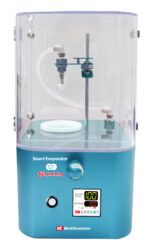This readily enables to evaporate DMSO, water or high-boiling point solvents or even solid samples with vial.

We had an interview with Mr.N in the University C who is working on the study of synthesis, structure and physiological activity of organic typical element compounds.
Interviewee:
Mr.N in the University C
What type of research are you in charge of?
-Our laboratory is engaged in research on the synthesis, structure and physiological activity of organic typical element compounds, and we use Smart Evaporator for various operations such as column purification solution, solution after NMR measurement, reaction mixture.
How exactly do you use Smart Evaporator?
-Basically, we use a rotary evaporator with an eggplant shape flask when a sample quantity is large. We then transfer that to a vial of 20 ml or 50 ml, and then concentrate that with Smart Evaporator. Also we concentrate samples that are transferred into vials after NMR measurement, or put a reaction mixture in a vial then concentrate that with Smart Evaporator.
What are the types of solvents, their quantity, and temperature settings?
-The solvents are chloroform, dichloromethane, ether, ethanol, DMSO, water, etc. and the quantity is 2ml~ 15ml. Usually samples are evaporated at 40 ℃, but 70 ~ 100 ℃ when with high boiling solvents.
Do many of you like using Smart Evaporator?
-Yes. 14 students in our lab are often using it every day. Our lab has many different kinds of vials, but your Spiral Plug is compatible with them all so they find it easy and convenient.
How does it make you easier exactly from the past?
.-When we mainly used a rotary evaporator, we use a rubber stopper or a filter adapter to set a vial. However, this installation was troublesome and with risk to drop a vial in a water bath. But now we can straight evaporate with a vial, less often to use eggplant shape flask, and we now have more space for operations. Our experiments include small scaled samples like a few mg, so thank that we can reduce sample loss.
Do you also use a rotary evaporator together with Smart Evaporator?
-Yes. We have both on the same bench. In the past, when we tried a solid sample, the sample got splashed just before evaporated, but the situation got solved with Smart Evaporator. We use both depends not only on sample quantity but also on types of samples.
Thank you for finding our device useful. We also thank you bought two units.
-I didn’t expect this would be so useful for us when I first heard from your sales. We now have two units, and use them almost every day. This device should be necessary for the research like ours including the synthesis of organic compounds where many operations are carried with vials.
Thank you for your words. We hope to keep good cooperation.
-Me too. Thanks.
Summary
His research is on the synthesis, reactivity and structure of organic typical element compounds with the theme of functional molecules creations applicable to a wide variety of fields including organic synthetic chemistry, medicinal chemistry and material chemistry. He used a rubber stopper or a filter adapter to connect a vial to a rotary evaporator, but such operation is troublesome and risky to drop sample into a water bath. The Vacuum-assisted Vortex Concentration method applied for Smart Evaporator does not let the inner container reach to vacuum and it is compatible with vials, it lets people readily operate evaporation including high boiling solvents like DMSO or water and solid sample evaporation. From this interview I recognize again Smart Evaporator is convenient for concentrating small scaled sample in organic synthesis field.
(Interviewer: Kikuchi)
■Interested in what Smart Evaporator is? You can learn from here!
